Home Improvement Hazards

There is a wide range of home improvement projects, from simply fixing what’s broken to full-on makeovers and upgrades. While most turn to professionals for larger, more difficult projects, a lot of people have taken to the do-it-yourself approach for projects of all sizes. But no matter the skill level, professional or DIY, home improvement injuries can and do happen.

We collected data from the National Electronic Injury Surveillance System (NEISS) to determine the most common ways in which people injured themselves at home. The data only included emergency room visits involving injuries sustained by common tools and products used for home improvement. So where does the danger lie? Don your safety goggles, and keep reading to find out.
Trauma Caused by Tools
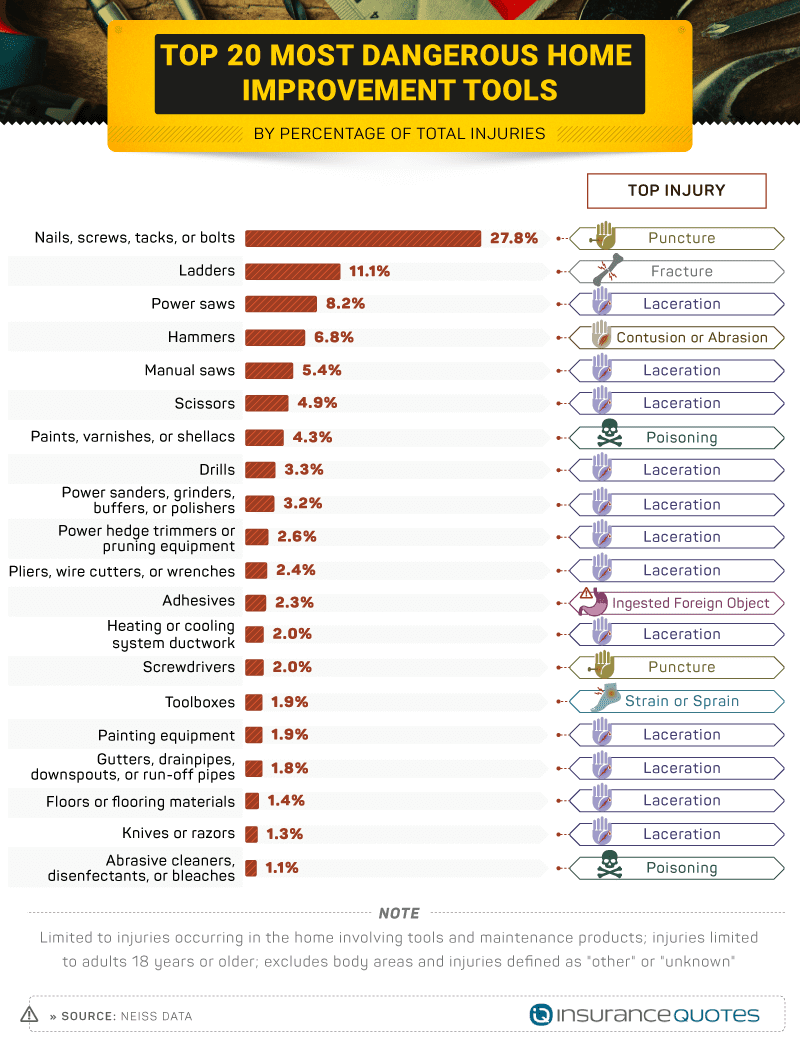
While hitting the nail on the head is the goal, it isn’t uncommon for hammers to completely miss and hit a finger instead. Lighter hits may be comical for onlookers, but heavy hits could result in a trip to the emergency room. Hammers were only responsible for about 7 percent of home improvement injuries – contusions and abrasions being the most common injuries – but accidentally hitting thumbs and fingers happens often enough for there to be a need for hammer-proof gloves. Buying a special pair of gloves isn’t the only way to protect fingers, though. Using a comb or clothespin to hold a nail in place while hammering takes fingers out of the equation, reducing the risk of injury.

On the receiving end of the hammer is where the danger really lies, however. Nails, screws, tacks, or bolts were responsible for about 28 percent of total home improvement injuries – more than any other tool. Puncture wounds were the most common injury caused by these tools, which are often deeper and can be prone to infection. Because of this, it is likely nail guns may have been involved in these injuries.
Nail guns have begun to replace hammers because they are significantly more efficient, but with a boost in productivity comes a boost in injury risk. Operators of nail guns should use extreme caution and be properly trained before use. Landing in the ER with a puncture wound is on the less severe side of possible injuries nail guns may inflict, though – the most severe being death.
Periods of Pain
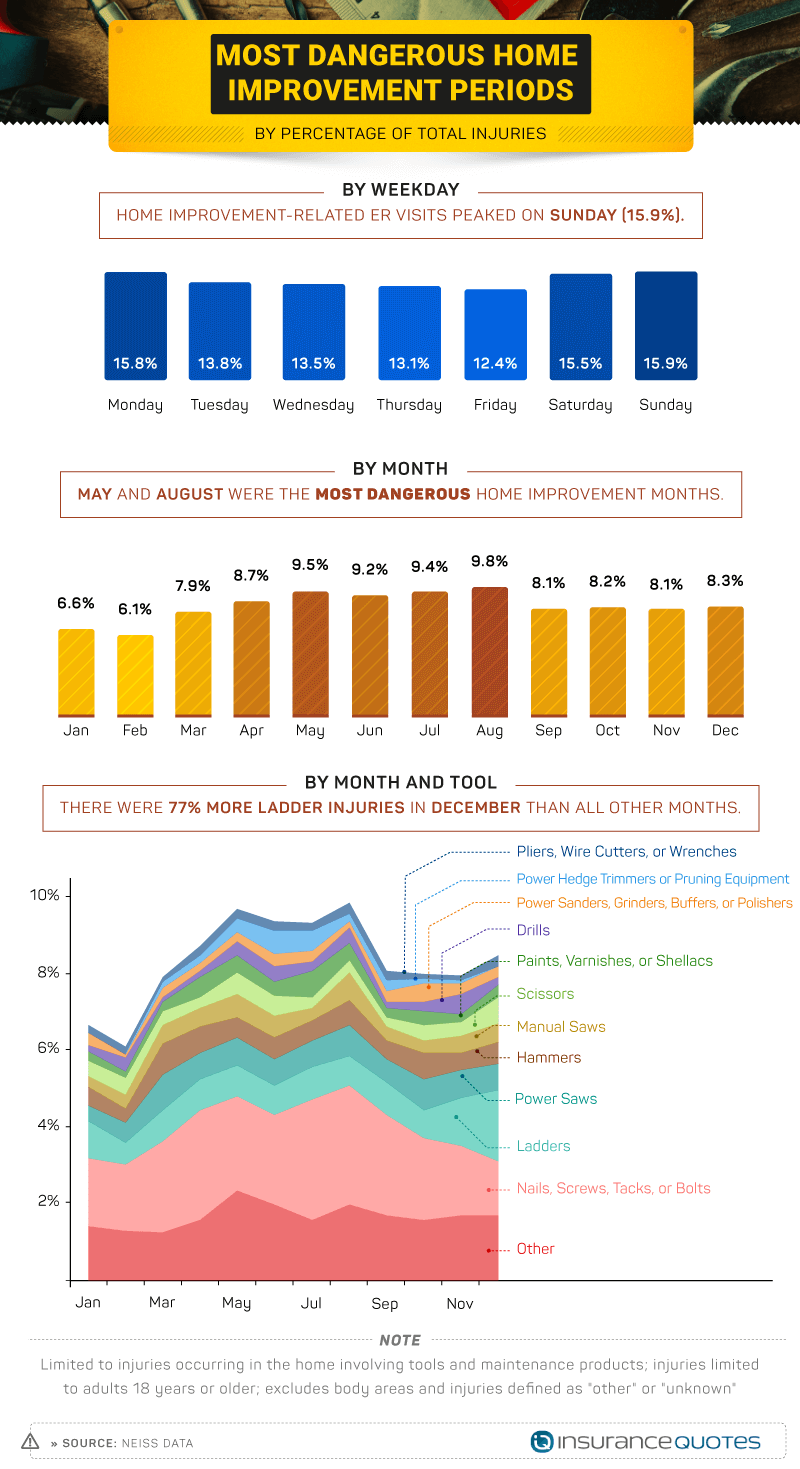
Sunday may be a day of rest, but when it comes to home improvements, it’s the busiest day for project-related injuries. On Saturdays, Sundays, and Mondays, at least 15.5 percent of home improvement injuries each were treated in emergency rooms. However, there was a steady decline starting on Tuesday, with the least amount of ER visits on Fridays.
Summer months also ranked highly when it came to home improvement-related ER visits. August had the highest rate of 9.8 percent, followed closely by May with 9.5 percent. With more free time and warmer weather, summer may be ideal for home improvement projects. Unfortunately, more projects being worked on may mean more injured ER patients.

Interestingly, when looking at specific tool-related injuries by month, there was a significant spike in injuries associated with ladders in December. There were 77 percent more ladder injuries in December than all other months, and the holiday season may be a factor. Putting up Christmas lights usually requires a ladder. And where there is a ladder, there is a risk of injury. Ensuring a proper setup of the ladder and taking extra caution while ascending or descending is crucial in preventing a fall or worse.
Bruised Bodies
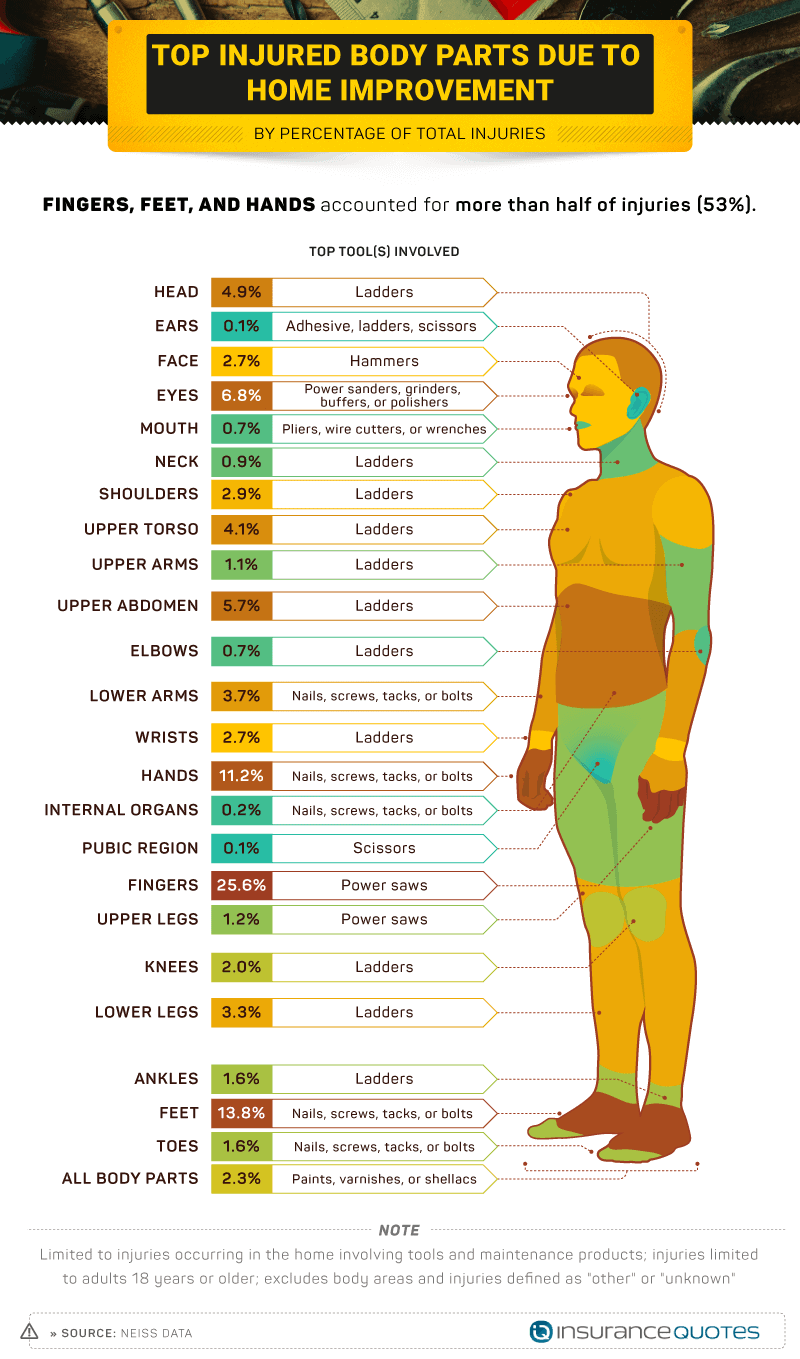
Hands are used in every home improvement project, making them extremely vulnerable to injury. Fingers, feet, and hands accounted for more than half of all injuries, with fingers making up about 26 percent. The top tool involved in finger injuries was the power saw, which is responsible for over 4,000 amputations every year. Ladders were the top tools for a multitude of body injuries likely suffered from a fall, including the lower torso, head, knees, ankles, and neck.

Common Complications
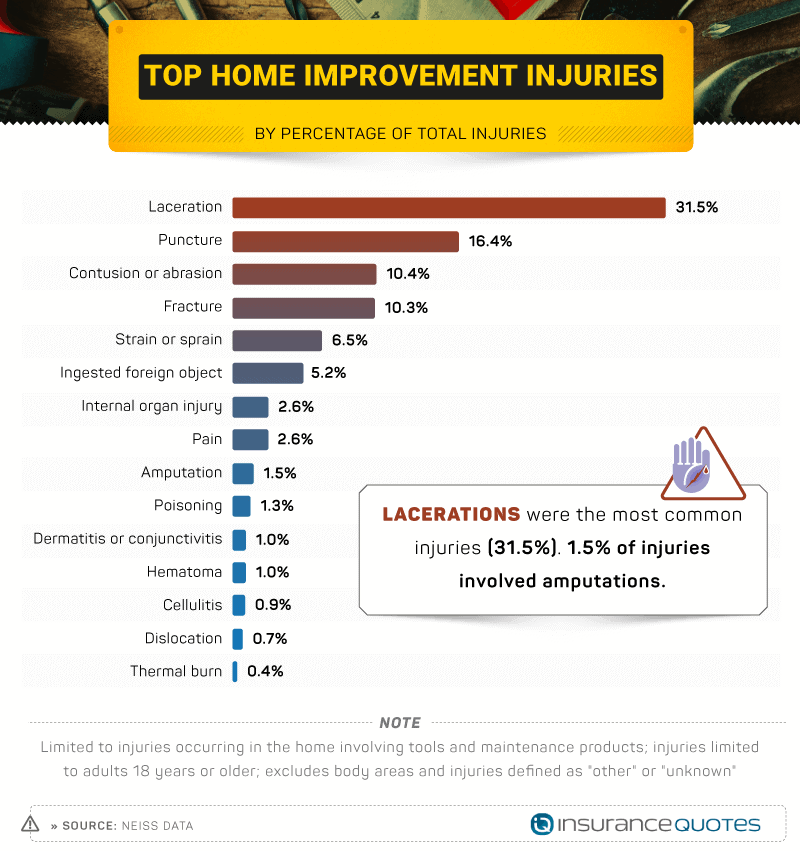
Amputations may be more common when analyzing injuries caused by power saws, but amputations only made up 1.5 percent of total home improvement injuries. The most common injuries were lacerations, accounting for 31.5 percent of diagnoses. Lacerations and punctures (the latter of which made up 16.4 percent of injuries) can vary greatly in depth and, therefore, severity.
However, keep in mind these data analyze injuries reported to emergency rooms, so the lacerations and punctures must have been severe enough to require emergency medical attention.

Who Gets Hurts the Most?
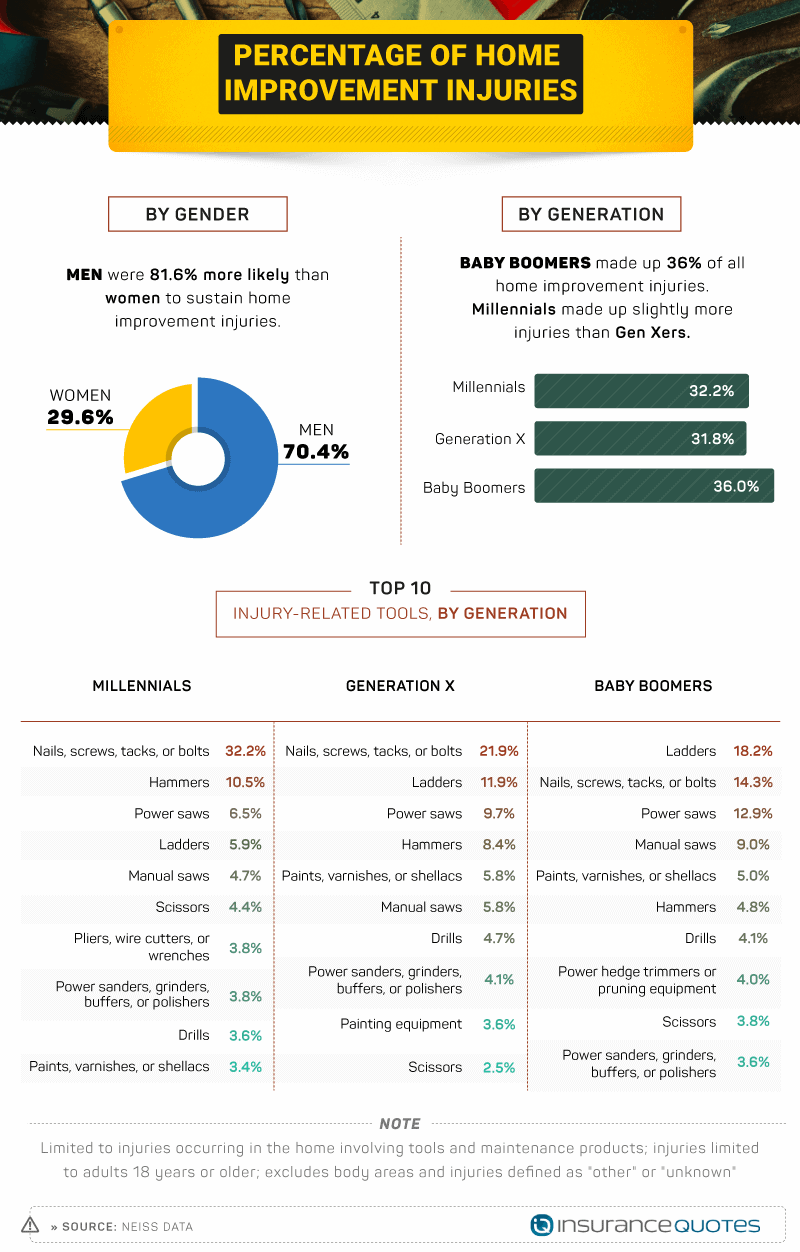
Of home improvement injuries, over 70 percent involved men. When it came to the generations, however, the distribution was closer. Baby boomers made up 36 percent of home improvement injuries, and millennials made up only slightly more than Gen Xers. But when we broke down each generation by the tool that caused an injury, we found some greater differences.
Ladder-related injuries ranked fourth for millennials, second for Gen Xers, and first for baby boomers. This doesn’t necessarily mean baby boomers use ladders more or fall from them more often, though.
The most recent study done to investigate the effect of age on ladder injuries found older people are simply more vulnerable after falling from ladders, and their injuries can be more severe than for younger people, even if they fall from lower heights.

Take Precautions, Prevent Injuries
Home improvement projects can be fun – a way to relieve stress, channel your creative side, or be a source of accomplishment. But the tools involved can be dangerous equipment and land you in the emergency room with serious injuries. Even trained professionals run the risk of injuring themselves.
To prevent serious injury, it’s vital to take extra precautions when using any tools while working on home improvement projects. If you’re taking the job into your own hands, use items found around your house to hold nails in place while hammering. Make sure ladders are set on solid, leveled ground, and take the climb slowly, so no steps are missed. Always use protective gear. Whether it’s gloves for your fingers and hands or goggles for your eyes, every layer helps.
And if injury occurs despite taking these precautions, make sure you have adequate health insurance to cover any medical assistance you may need. Trips to the emergency room can be expensive, but with the right insurance plan, expenses can be minimized. At insuranceQuotes, you can freely explore health insurance options to ensure you’re getting the most out of your policy.
Methodology
We collected data on 5,705 ER visits from the National Electronic Injury Surveillance System (NEISS) for 2016 (latest year available). Data were limited to injuries occurring in the home and involving home improvement products and tools, as specified in the NEISS code book.
The data we are presenting rely on information documented from ER visits and do not represent unreported injuries. No statistical testing was performed, so the claims listed above are based on means alone. As such, this content is exploratory.
Sources:
- https://www.cpsc.gov/cgibin/NEISSQuery/home.aspx
- https://www.inc.com/joel-comm/why-the-huge-do-it-yourself-market-is-just-getting-started.html
- https://medlineplus.gov/ency/imagepages/19616.htm
- https://www.cdc.gov/niosh/topics/nailgun/
- https://www.huffingtonpost.com/jack-choros/how-to-increase-the-value-of-your-home-during-summer-renovation-season_b_10444222.html
- https://www.nachi.org/ladder-safety.htm
- https://www.npr.org/2017/08/10/542474093/despite-proven-technology-attempts-to-make-table-saws-safer-drag-on
- https://www.ncbi.nlm.nih.gov/pmc/articles/PMC4419695/
Fair Use Statement
If you’d like to share these DIY disasters, you’re welcome to use this project’s findings for noncommercial purposes on your own site. We simply ask that you attribute insuranceQuotes accordingly by providing a link to this page.
